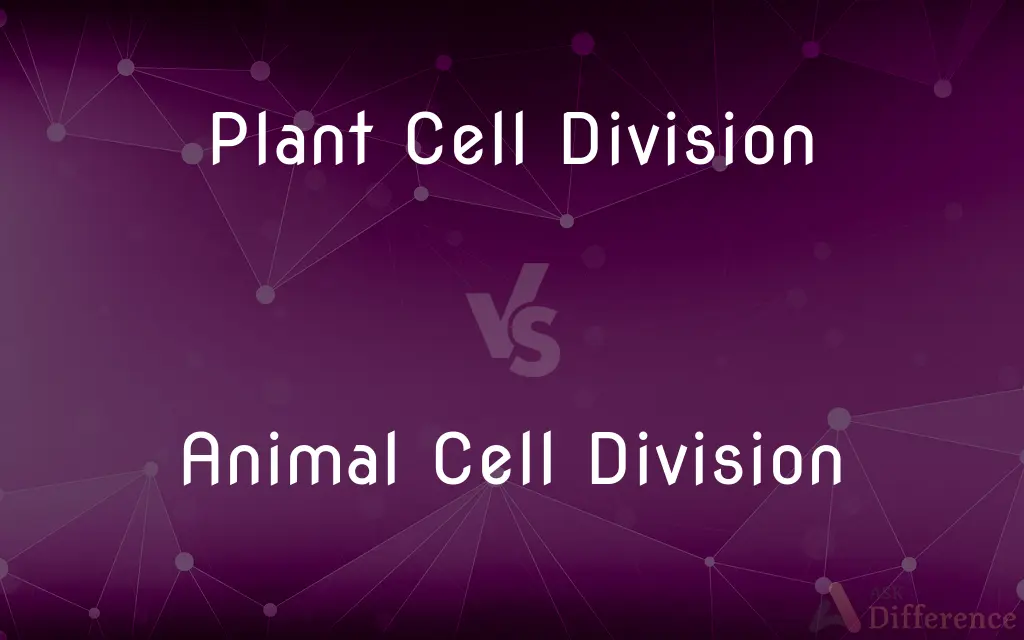Plant Cell Division vs. Animal Cell Division — What's the Difference?
By Tayyaba Rehman — Published on January 3, 2024
Plant cell division involves a cell plate formation, while animal cell division uses a cleavage furrow for cytokinesis.

Difference Between Plant Cell Division and Animal Cell Division
Table of Contents
ADVERTISEMENT
Key Differences
Plant cell division, specifically during cytokinesis, is marked by the formation of a new cell wall called the cell plate. This plate develops into a new cell wall, separating the daughter cells. Animal cell division, in contrast, involves the formation of a cleavage furrow that pinches the cell into two daughter cells.
In the context of mitosis, plant cells do not have centrioles, while animal cells use centrioles to form spindle fibers that help in chromosome separation. Plant cells rely on a structure called the preprophase band to predict the division site.
Plant cells often divide in a fixed pattern contributing to the plant’s growth in specific regions known as meristems. Animal cell division is not typically restricted to certain areas, allowing for more diverse development and tissue repair throughout the organism.
The rigid structure of plant cell walls necessitates the cell plate formation during cytokinesis, ensuring proper division. Animal cells, having only a plasma membrane, can form a cleavage furrow that constricts the cell into two separate entities without needing to form new structural walls.
During plant cell division, vesicles derived from the Golgi apparatus coalesce at the middle of the cell to form the cell plate. In animal cell division, the actin and myosin microfilaments contract to form the cleavage furrow, pulling the membrane inward to divide the cell.
ADVERTISEMENT
Comparison Chart
Division Site
Occurs at meristems
Occurs throughout the organism
Cytokinesis
Cell plate forms to divide the cell
Cleavage furrow constricts to divide the cell
Structural Features
Lacks centrioles; has a rigid cell wall
Contains centrioles; has a flexible membrane
Division Process
Vesicles form the cell plate
Actin and myosin form the cleavage furrow
Growth Pattern
Patterned growth contributing to plant shape
Enables growth and tissue repair
Compare with Definitions
Plant Cell Division
Results in two daughter cells encased in their own cell walls.
Post plant cell division, two distinct cell walls become evident.
Animal Cell Division
Cell division can happen anywhere in the body.
Stem cells in bone marrow undergo animal cell division to produce blood cells.
Plant Cell Division
Involves vesicles coalescing to create a new wall.
Cell division in plants is marked by the fusion of Golgi-derived vesicles.
Animal Cell Division
Animal cells divide using a cleavage furrow.
During animal cell division, the cell membrane pinches to form two cells.
Plant Cell Division
Process of dividing a plant cell by forming a cell plate.
During plant cell division, a new cell wall begins to form in the cell's center.
Animal Cell Division
Centrioles are involved in the process.
Centrioles organize spindle fibers that are crucial during animal cell division.
Plant Cell Division
Division occurring specifically at plant meristems.
The plant cell division at the shoot apical meristem adds height to a plant.
Animal Cell Division
Occurs without the formation of a cell wall.
After animal cell division, each daughter cell is surrounded by a flexible membrane only.
Plant Cell Division
Characterized by the absence of centrioles.
Plant cells divide using a preprophase band instead of centrioles.
Animal Cell Division
Essential for growth and tissue repair.
Animal cell division in the liver regenerates damaged tissue.
Common Curiosities
Is cell division the same in all animal cells?
The basic process is similar, but some details can vary by cell type.
Why don’t plant cells need a cleavage furrow?
Because their rigid cell walls don't allow for the membrane to pinch in.
Do animal cells form a cell plate?
No, animal cells use a cleavage furrow.
What role do centrioles play in cell division?
In animals, centrioles help organize spindle fibers for chromosome separation.
Do plant cells ever use a cleavage furrow?
No, plant cells cannot form a cleavage furrow due to their cell wall.
What initiates plant cell division?
It's initiated at specific sites called meristems.
How does animal cell division start?
It is often initiated by signals for growth or repair.
Are spindle fibers used in plant cell division?
Yes, but they are organized differently due to the absence of centrioles.
Can plant cells form a cleavage furrow?
No, they form a cell plate instead.
Do all plant cells have the ability to divide?
Not all; some differentiated cells lose the capacity to divide.
Where does plant cell division primarily take place?
At the growing tips, or meristems, of plants.
How do cells know where to divide in plant cell division?
The preprophase band marks the future cell division site.
Can animal cell division result in a plant-like cell wall?
No, animals do not produce a plant-like cell wall.
What happens to the cell plate after plant cell division?
It develops into a new section of cell wall between daughter cells.
What is the significance of cytokinesis in cell division?
It's the process that physically separates the cytoplasm into two cells.
Share Your Discovery

Previous Comparison
JOIN in SQL vs. UNION in SQL
Next Comparison
ERP vs. SAPAuthor Spotlight
Written by
Tayyaba RehmanTayyaba Rehman is a distinguished writer, currently serving as a primary contributor to askdifference.com. As a researcher in semantics and etymology, Tayyaba's passion for the complexity of languages and their distinctions has found a perfect home on the platform. Tayyaba delves into the intricacies of language, distinguishing between commonly confused words and phrases, thereby providing clarity for readers worldwide.














































